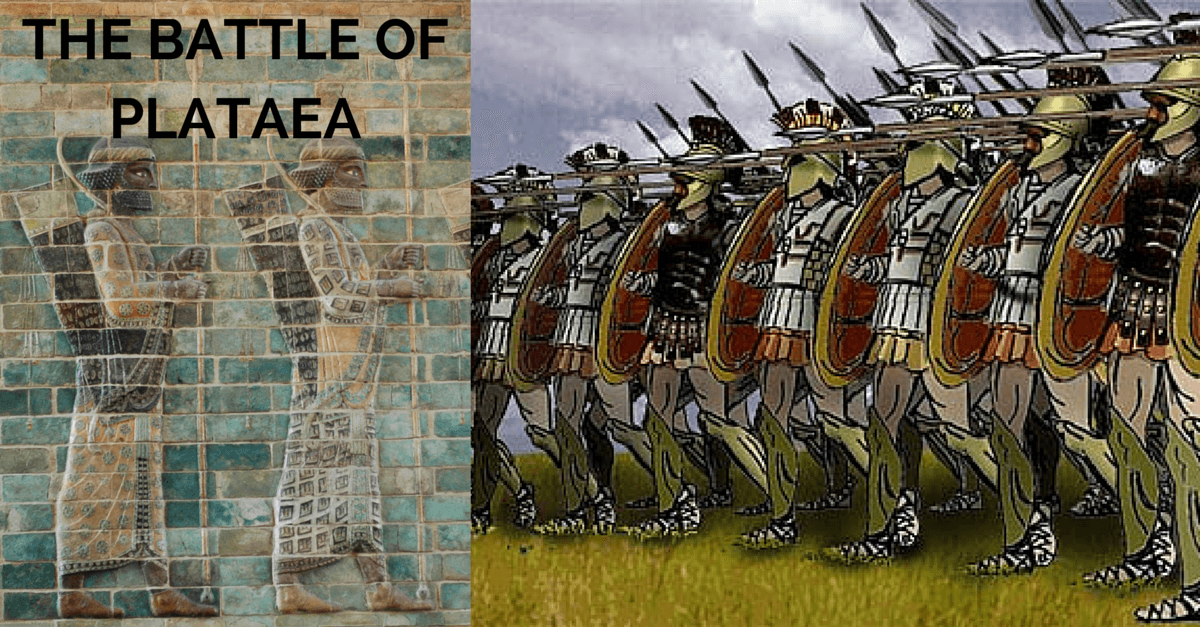The battle of Plataea is not an event that gets instant recognition like the famous battles of Marathon, Thermopylae and Salamis. It often gets overlooked for many reasons, primarily because it was a battle of immense confusion and it is hard to see definite tactics at play. Others focus on the naval battle at Salamis as the defining turning point in the war. While Salamis was indeed an amazing victory for the Greeks, the near simultaneous land and naval victories at Plataea and Mycale were the battles to end the possibility of Persian victory. After the defeat at Salamis, the Persian navy still outnumbered the Greeks and the land army was still larger than any force the Greeks could field and was further bolstered by Greeks fighting for the Persians. The Greeks still had one major battle left to wipe away their fears of Persian domination.
After the battle of Salamis in 480 BCE, which decimated the Persian navy, Xerxes sailed back to Persian territory because he was concerned that the Greeks would seize the opportunity to destroy the pontoon bridges over the Hellespont and trap his land army in Europe. This was not at all a reduction of the war effort as Xerxes left the skilled general, Mardonius, in command of 80,000-120,000 handpicked troops, including a large number of pro-Persian Greeks such as the Thebans. Mardonius was able to sack Athens for a second time and sought open battle with the Greeks, but only on flat ground where he could utilize his cavalry effectively.
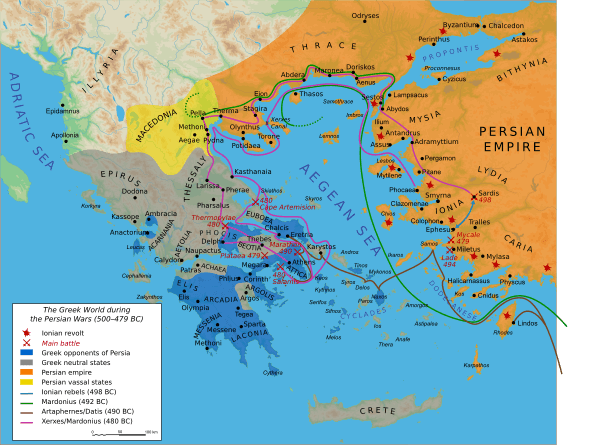
A strategic stalemate ensued when the Spartans and their allies withdrew to defend the Isthmus of Corinth and would not risk leaving and being caught in Mardonius’ ideal flat terrain. Mardonius also would not risk assaulting such a defended area. Mardonius focused his energy on the displaced Athenians and attempted to diplomatically take them out of the war. Athens sent delegates to Sparta to warn them that they may just accept these terms if Sparta did not march out to attack. The Spartans realized the magnitude of this ultimatum and marched out with great haste to meet Mardonius.
The Greeks were able to communicate and raise a force of three mostly equal contingents: the Athenians, the Spartans and a collection of all other city-states sending troops. The number of Greek troops reported by Herodotus is worth investigating. His count of 38,700 hoplites from the various city-states is generally accepted however Herodotus claims that there were seven helots per Spartan hoplite, so 35,000 slaves under 5,000 Spartans. With such a history of helot uprisings some people have argued that the helots would not have been able to be controlled on the march, vastly outnumbering their Spartan masters. On the other hand it is possible that the number is correct and the helots were brought in such numbers to lower the likelihood of a revolt while the army was gone. Either way the Greek army totaled over 80,000 men when including slaves who largely acted as squires. However only the 38,700 hoplites are credited with having any impact during the actual battle.
The Persians prepared to meet the Greeks by constructing a fortified camp just north of the Asopus River, leaving a favorable plot of flat land to the south were the Greeks were heading. The Greeks saw this trap as they approached and set up their lines on Asopus ridge running parallel to the Persian lines. There was also a spring on the ridge behind the Athenian left which was able to supply the entire army. Another stalemate ensued and Mardonius may have attempted to spread dissention by sending different messages to the different commanders.
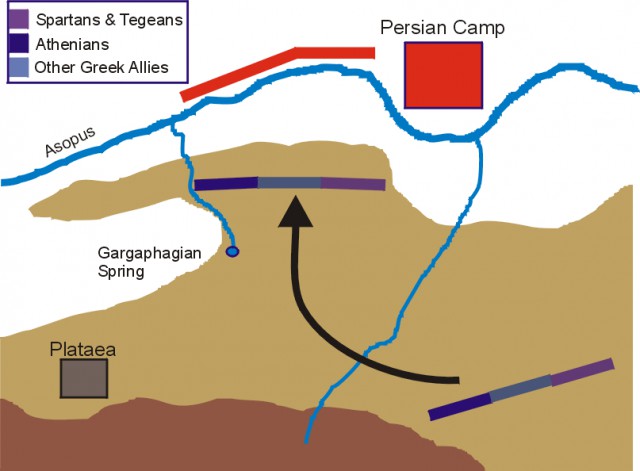
Mardonius continued to attempt to lure the Greeks into the plain by harassing them with his cavalry led by Masistius. The attacks which were meant to simply entice the Greeks to move were actually causing considerable damage to the Greek lines and Masistius, upon seeing that the enemy was struggling and on the verge of breaking, pressed the attack and was on the verge of routing the 3,000 Megarian hoplites when 300 Athenians supported by at least as many archers came to their aid.
The ensuing skirmish was hard fought on both sides and the tide turned when an arrow struck down Masistius’s horse and he was overcome and killed by a wave of Athenian hoplites. Herodotus goes into some detail about how impressive of a figure this man was; not only was he the cavalry commander but he was tall and strong and had a corslet of golden scales with a scarlet cloak. It was important for both sides to secure the body as it was a morale booster for the Greeks and the Persian cavalry just wanted to give their commander a proper funeral. A fierce struggle for the body ensued which switched hands three times and ended up with the Athenians while the rest of the Persians were forced to withdraw.
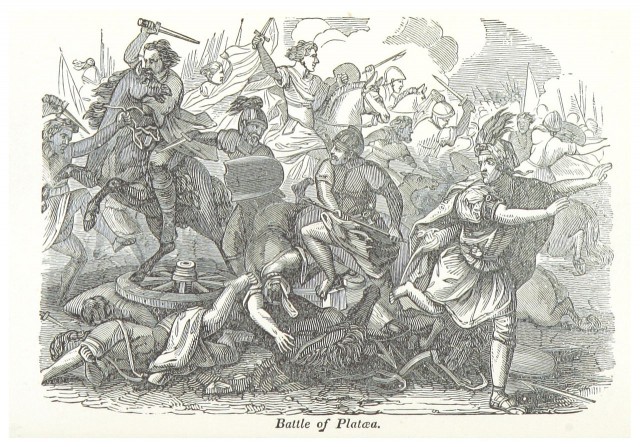
This was a huge blow to Persian morale as Masistius’s reputation was second only to Mardonius’s. Mardonius played it safe for several days and neither side wanted to commit, Mardonius fearing that his men’s morale was too weak and the Greeks fearing the Persian cavalry. Mardonius reverted back to the small scale, but effective, cavalry raids. The Greeks had no answer for the smaller scale cavalry engagements and they soon began disrupting their supply lines. On the eighth day a cavalry raid succeeded in disrupting the spring which supplied the water for the Greeks and the Greeks situation became dire. The Greeks were no essentially under siege with severely limited food and water especially considering the size of their force with the helots and other attendants.
A council was convened with all the significant groups represented under the overall command of the Spartan king regent Pausanias. It was decided that come nightfall the three separate contingents of Greeks would withdraw to an area in front of the town of Plataea which would provide water and raised ground for the whole army. After the meeting things did not go at all how the Greeks originally planned.
Herodotus explains that upon hearing the plan to retreat, Amompharetus, a Spartan company commander refused to retreat on the grounds that it was against Spartan law to run from the enemy. It supposedly took until dawn for Pausanias to decide to retreat without Amompharetus’s company and the Athenians had also not moved because they were unsure of the Spartans plans anymore. The Greek center of multiple city-states, however had gotten about to the town of Plataea by daybreak. Mardonius saw this staggered retreat and took it for a full rout and attacked with great haste.
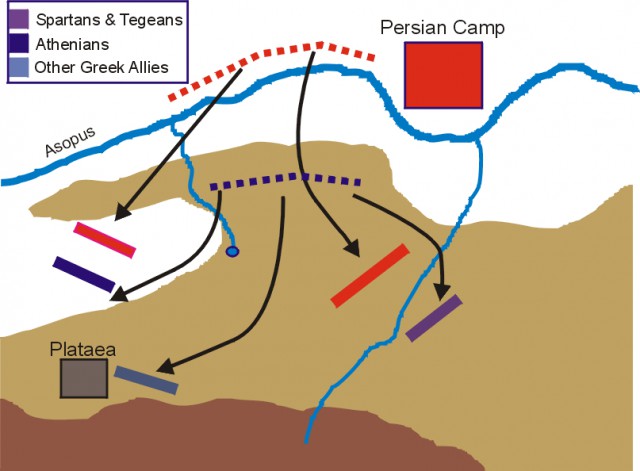
While this is a possible series of events as to how the Greeks wound up half retreated and scattered around the battlefield Peter Green in his book The Greco-Persian Wars thinks it is a “monumentally silly” story. According to Green there is no way that the acting king would take such insubordinate attitude from his own men and the matter would have been dealt with in minutes. Green then proposes that the Spartans remained behind to lure Mardonius into thinking that the other Greeks were fleeing.
Taking both stories into account, it seems much more likely that Green is right and Herodotus did not know the true events and filled in what he thought happened. If we do take Green’s account as true then it shows how daring Pausanias’s strategy was. By dawn the army was scattered in three places but was, in a sense, meant to be. The center was sent to the initially agreed upon site to form a secure fallback point however they were still en route to the hill. The Athenians were attempting to protect the flank of the center while they retreated and the lone company under the Spartan Amompharetus was left in the open not because he refused the retreat order but because he wanted the honor of being the prime bait for Mardonius’s cavalry. The bravery of Amompharetus was matched by his skill in maneuvering as he was able to rejoin the main force of Pausanias moments before the cavalry charge hit.
Though together and ready for the charge, the Spartans may have been too good at being bait as they were hit hard by the cavalry and had to request aid from the Athenians on the left flank who were stopped short by the Persian-allied Greeks including skilled cavalry from Macedon and Thessaly. The Spartan right wing was left to endure the missiles of the Persians who were doing their best to keep their distance. The Spartans showed great discipline in keeping formation to weather the storm and finally breaking and charging the Persian left wing.
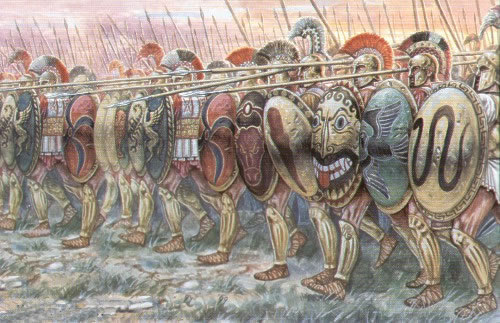
The close combat at the battle of Plataea was different than any other Greco-Persian engagement because the Persians actually feared for their lives if they were to lose, previously they had a hard time but knew they would ultimately win at places like Thermopylae and the assault of the Acropolis of Athens. In this battle the
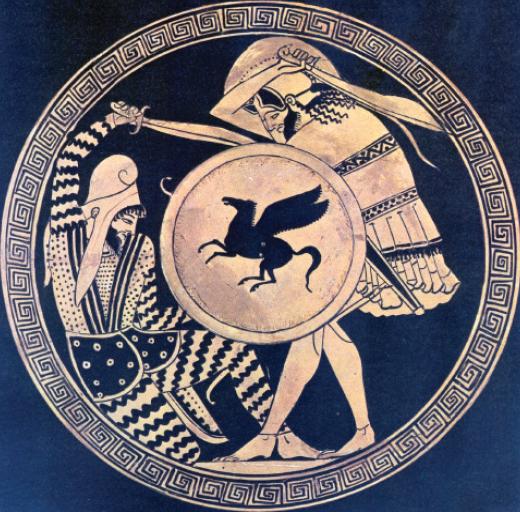
Greeks were fighting to finally expel the Persians from their land and the Persians were fighting to not get slaughtered. The fighting was very fierce with the Persians grasping and attempting to break Greek spears and wrestling shields away. Combat would continue with the Greek sword the Xiphos which would crush the Persian’s wicker shields. Even the heavy Persian immortals had no armor strong enough to fend off Greek weapons. The Spartans were still hard pressed but they were practically churning through the enemy.
The Athenians on the other hand were fighting fellow Greeks who had allied with the Persians and were having a very hard time of it especially due to the constant pressure exerted by the Greek cavalry. Luckily for the Athenians, part of the Greek center consisting mainly of untrained men came rushing back to the battle after retreating farther than there were initially supposed to. The Persian-allied Greek cavalry easily drove them off but in doing so gave the Athenians time to breathe and regroup and thus were able to effectively hold firm against the assault.
On the right wing the Spartans finally received aid when a large column of hoplites led by the Corinthians from the center crashed into the Persians off the left flank of the Spartans. The Persian left held fast in part because their commander was with them and near the front urging them on. Neither side was gaining much momentum until Mardonius was struck in the head by a rock thrown by a Spartan named Aeimnestus and killed. The news of his death spread quickly and the entire Persian army fled. The Persian-allied Greeks simply headed to their own cities and the Persians retreated to their own camp with the exception of the commander of the Persian center, Artabazus who withdrew as many troops as he could at left Greece immediately and didn’t look back until he was back across the Hellespont.
The relatively fresh Corinthians attempted to pursue Artabazus while the Spartans were occupied by the Persians who had manned the defenses of their heavily fortified camp. Pausanias called on the Athenians to help as they had far more experience with walls. The assault on the camp brought many casualties on the Greeks as the Persians knew they would surely die if they failed and fought with grim determination. A breach was eventually opened and thousands of hoplites poured in and slaughtered all in sight and turned what was a stout defense into utter chaos; at this point all semblance of order was gone and men were using whatever weapons they could find and were powered by adrenaline and rage.
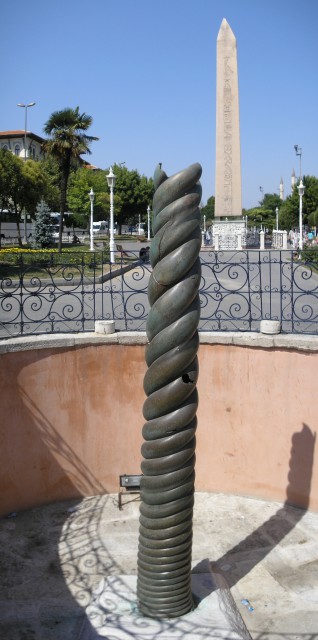
Aside from the contingent withdrawn by Artabazus, only 3,000 Persians remained in the camp after the order to halt. This is the only reliable estimate we have of casualties for the battle. Herodotus’s numbers are simply irrational as he puts the Persian losses at 257,000 and the Greek losses were 159, but it is well known that Herodotus greatly exaggerates his numbers. Given the uniform heavy armor of the hoplites it is safe to assume that there would be less than expected casualties and estimates tend to range from 1,300 to 10,000. The Persians losses are also very difficult to figure but must have been considerably high as the extended combat was by no means favorable to them and the slaughter at the camp alone was responsible for 7,000 losses.
With the total destruction of the Persian fleet either on the same day or at least in that same month at the battle of Mycale, the Persian invasion was over. Peter Green wraps up this battle very nicely by saying “At long last the Persian shadow had been lifted from Greece, this time forever. . . . Both by sea and land, Xerxes’ defeat was absolute.” The Greeks would later go on the offensive against the Persian Empire eventually gaining much territory. Many of the city-states would form the Delian League to be led by Athens under the guise of protection against another Persian invasion which would never come.
By William McLaughlin for War History Online
